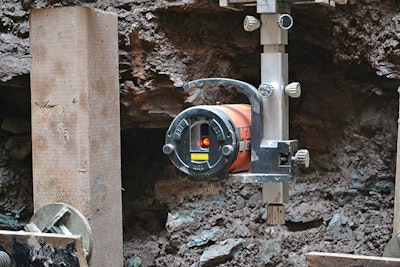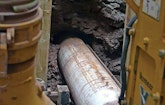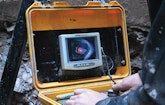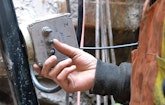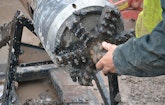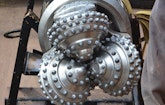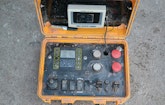
Interested in Rehab/Relining?
Get Rehab/Relining articles, news and videos right in your inbox! Sign up now.
Rehab/Relining + Get AlertsContractors and utilities are constantly on the lookout for alternative technologies that can help them avoid the expense and disruption of open-trench digging to repair or replace underground sewer or waterlines.
If the task is simply to repair and strengthen existing pipes, a number of pipelining technologies offer trenchless solutions. When the pipe itself must be replaced or a new line must be installed where none existed previously, trenchless alternatives are much more challenging.
Vermeer Corp. of Pella, Iowa, recently introduced one approach: the laser-targeted underground AXIS guided boring system.
Vermeer, which also manufactures horizontal directional drilling machinery, offers the AXIS system as an alternative to HDD where precision is critical, such as when setting the grade for a gravity-fed sewer line.
A sewer line boring and installation project in the Canadian community of Oakville, Ontario, provided an opportunity in early April 2012 to see the AXIS system operating in the field.
Oakville is about 30 miles southwest of Toronto on the northern shore of Lake Ontario. The project was conducted under the direct supervision of James Vis, a foreman with Avertex Utility Solutions Inc.
Ryan Linde of Avertex was the operator for the AXIS system. Bo Howell, an engineering technician from Vermeer’s plant in Pella, was on hand to advise Linde and the Avertex crew.
Avertex, based in Orangeville, Ontario, was contracted for the project by the Regional Municipality of Halton, Ontario, which is responsible for utilities such as water and wastewater. Avertex owns one of just two AXIS systems in use in all of Canada.
The Oakville project entailed the installation of a new gravity-fed sewer line in a residential neighborhood. The old line was powered by a pump station at its starting point, explained Vis. The AXIS system was used to avoid disrupting the neighborhood, with its numerous mature trees, with an open-trench project.
When complete, the line was to run from the dead end of Timber Lane, the location of the original pumping station, along two blocks of Seneca Drive to West River Street, where it was to connect with an existing sewer line. In all, about 1,640 feet of line was installed using the AXIS system.
Walk-around
The AXIS system consists of a drill rack operated from inside an underground pit and a power supply that is set up on the ground above the pit.
When a pipeline is installed using the AXIS system, the process is typically completed in 300- to 400-foot increments. For each increment, a pit is dug at the starting point and at the ending point of the run. The drill rack is set up and operated from the first pit and bores through the dirt to the second pit. As the bore is completed, a manhole is typically constructed at each pit, and the rest of the pit is then filled in.
The heart of the AXIS system is a hydraulic-powered thrust and pullback carriage assembly and gear box that pushes the drill casing forward and turns a cutter bit at the end of the drill head that bites into the underground soil. The rack is seated on a leveling frame. The assembly altogether is 11 feet 2 inches long, 3 feet 9 inches wide and 5 feet high.
The thrust/pullback mechanism drives a 13.5-inch-diameter drill head mounted on a 2-meter (about 6.5 feet) drill casing unit into the soil. As the head goes deeper into the soil, additional 2-meter drill casing units are inserted behind the lead unit to extend the system’s reach. Different drill bits are available depending on the nature of the medium, such as rock or clay, through which the hole is being bored.
A laser unit provides precision guidance for the system to maintain exact grade. The laser unit is securely mounted at the rear of the pit, opposite where the bore is to be made. A camera in the drill head allows the operator to see right in front of the drill as it is operated, aligning a target with the laser to ensure a straight, steady bore.
The cylindrical drill casing units include a central shaft that turns inside the unit, turning the drill bit at the front. An external channel accommodates cable from the camera and its lighting at the front of the auger so that the casing units maintain a smooth, cylindrical external profile.
The casing units also include two internal channels. The upper channel is for air to move forward through the shaft to the front so that debris can be vacuumed out of the way and pulled back through the lower channel.
The air in the upper channel also keeps it cool, which is necessary to keep the laser beam on target, said Howell. Heat can bend the laser off target, he explained.
The laser is directed at a target positioned inside the lead cylinder on the backside of the drill head so the operator can maintain a straight shot. The beam shines through the upper channel.
Vermeer also sells a vacuum system to remove the debris from the boring project. Avertex, however, removes debris using a combination vacuum truck from the contractor’s fleet.
The superstructure of the rack unit includes a space where the operator can be positioned under the Falling Object Protective System. The operator controls the system from a console mounted inside a portable case the size of a small toolbox; the console is attached via cables and then unhooked at the end of each working session. The control console includes simple buttons and a joystick-type control for the drill and the thrust/pullback mechanism as well as a television screen for the camera.
Power for the system comes from a 140 hp diesel motor situated aboveground, adjacent to the operating pit. The motor is encased in a moveable, windowless, shed-like sea container measuring 8 feet long, 8 feet high, and 6.5 feet wide.
Operation
The observation took place over a day and a half on the last stretch of the new line, a 311-foot run.
In advance of the boring done on April 3 and April 4, a crew from Avertex had dug a rectangular pit 10 by 20 feet in perimeter and 23 feet below the street at the intersection of Timber Lane and Seneca Drive. A second pit was dug where the run was to end at the dead end of Timber Lane. That end of the run is the highest point in the line and the starting point for sewage flow.
The AXIS system was installed in several steps. First, the laser guidance equipment was positioned precisely based on surveyor’s readings. The laser then was programmed using its own controller — a device about the size of a TV remote — for the exact grade of the bore and secured on a horizontal wooden beam erected along the rear wall of the pit behind where the boring unit was to be set up. Maintaining a secure position for the laser is essential to ensure consistent accuracy. Once set up, work crews must be careful not to bump it out of alignment, Vis and Howell explained.
Because the endpoint was to be the highest point in the gravity-fed line, the AXIS laser was set to bore at a consistent 0.6 percent grade upward.
After securing the guidance laser, the Avertex crew lowered the leveling frame into the pit and positioned it to be consistent with the laser beam. Once the frame was set, the rack was lowered onto it and secured; then hydraulic hoses to power the motors on the rack, the vacuum hose for debris, and electric cables were all attached.
A tri-cone bit was used for rock. This consists of three toothed, slightly spherical, intermeshed components that constantly revolve to cut out the rock. The tri-cone bit was attached to the lead drill casing unit.
The hydraulic motor provided power both to the revolving drill head components and to push the entire shaft forward. Only the cutter bit itself rotates or revolves during operation. The drill head to which the bit is attached and the cylindrical casings that extend the shaft do not.
With Linde operating the machine, the drill head cut into the rock as the gearbox pushed it forward.
The gearbox pulled back at intervals of 6.5 feet, leaving the drill head and shaft in the earth. A crane operator lowered the next drill casing into the pit, where crew members placed it on the rack behind the previous casing. Crew members aligned male and female connections between the two casings and latched the new casing to the previous one. Cable was then tucked into the external channel on the new casing, and the casing unit was numbered in sequence to keep track of the progress of the shot.
Linde used the console to send the drill casing forward into the earth another 2 meters, then again drew back the gearbox so that another casing could be inserted.
The process was repeated over several hours, during which the machine made steady progress into the earth, drilling about halfway to the final endpoint.
After the unit had punched through the rock, it entered a heavy clay soil that required an alternative boring bit. The shaft was removed, casing by casing, so that the tri-cone bit could be removed and the replacement bit installed. Then the lead casing with the drill head and bit was returned to the hole and again the shaft extended, casing by casing, into the ground.
User’s comments
To avoid disrupting traffic in the residential neighborhood where the project was taking place, and to avoid damage to numerous mature trees in the immediate area, avoiding open trench work was a critical consideration, Vis said. The depth of the line — 30 feet at its deepest point — was another consideration. “To dig a trench safely 30 feet deep is tough,” he said.
And horizontal directional drilling, he said, would not have enabled the degree of precision in the angle of the grade that the gravity-fed sewer line required.
The laser guidance feature has proved to be extraordinarily accurate and efficient, Vis noted. Once the laser is programmed to the precise grade required, he said, “You can maintain that grade the whole duration of the shot.”
Machine operator Ryan Linde says the AXIS system takes some getting used to, because the drill has to be “steered” to keep the target centered in the laser beam, instead of the more intuitive approach of moving the beam to match a target.
“If you’ve run other drills before, it’s completely different,” he said. “But once you’ve been shown how to use it, it’s pretty straightforward.”
Linde said the machine is very easy to control, with a joystick for steering and two levers, one for thrusting forward and one for rotation of the drill bit.
When the AXIS system is used for a line that will require multiple increments, it’s typical to use the pit at the end of a run as the starting point and installation site for the mechanism for the next run. But it doesn’t have to be done that way.
Vis explained that on the Oakville project, the crew saved time by boring up grade in one direction, and down grade in the other, from the same pit. That reduced set-up time.
Manufacturer’s comments
Vermeer engineering technician Bo Howell explained that the steering shell on the unit is a precise 13.5 inches in diameter. When boring a hole, maintaining that maximum diameter allows the operator to make precise adjustments as needed to maintain a consistent grade without deviation.
When wider diameter bores are required, the line is reamed out to the wider size as the unit is pulled back after the bore. The pipe is pulled in and additional debris removed during the same pullback operation, he said.
The Oakville project was to conclude with punching through the pit at the end, then pulling back new piping using the same machine.
Because of the soft clay soil in the ground where the shot was made, however, the crew ran into some unexpected problems that were unrelated to the AXIS system itself.
Late in the day on April 3, clay from the drill obscured the lens of the closed circuit camera. After several unsuccessful attempts to wash the clay off, the shaft had to be withdrawn so that the camera could be cleaned.
With that, the crew then opted to start the shot over with a fresh bore, which Howell and Vis explained was necessary to preserve the integrity of the sewer line shaft. Too many repeated bores into the same hole would weaken the earth surrounding the line and risk compromising the precise grade that the gravity-fed sewer required, Howell explained.
Vis said that was the first major hiccup in the project, and one reflective of the challenging soil conditions on the site and not any kind of problem with the AXIS system.
He noted that until the final shot, the entire project had required boring through the red shale that is most common in the area, and no problems had occurred.
